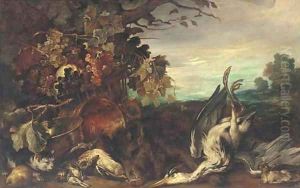Giovanni Crivelli, Called Il Crivellino Paintings
Giovanni Crivelli, also known as Il Crivellino, was an Italian painter who was active during the Renaissance period. He is believed to have been born around 1475, although the exact date and place of his birth are not well documented. His moniker 'Il Crivellino' distinguishes him from Carlo Crivelli, a more famous relative, possibly his uncle, who was also a prominent painter of the time.
Not much is known about Il Crivellino's life, and his death is similarly obscure, estimated to have occurred around 1500. Historical records suggest that he worked in the Marche region of Italy, which was also the primary area of activity for Carlo Crivelli. Giovanni inherited a style heavily influenced by his presumed relative, characterized by a meticulous attention to detail and a Gothic sensibility that was slightly out of step with the emerging Renaissance norms of his era.
Il Crivellino's works are lesser-known and fewer in number compared to those of Carlo Crivelli. They often feature religious subjects, as was typical for the period, with an emphasis on the use of gold leaf and ornate decoration. This decorative quality, along with a certain stiffness in the figures and adherence to the Gothic tradition, are hallmarks of his style.
Despite the scarcity of information, it is clear that Il Crivellino made contributions to the artistic landscape of his time, and his paintings, although rare, are valued for their historical and artistic significance. A number of religious institutions in the Marche region of Italy attribute altarpieces and other devotional paintings to Il Crivellino, and these works continue to be studied by art historians interested in the transition from Gothic to Renaissance styles in Italy.
